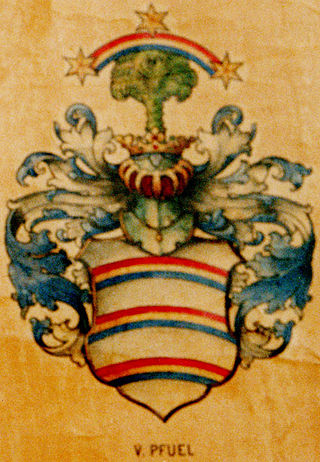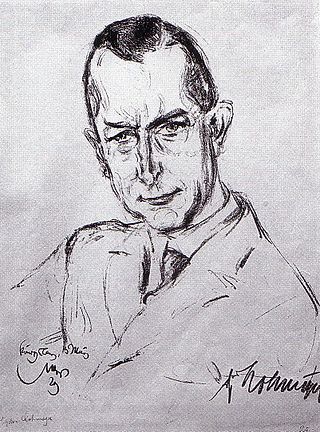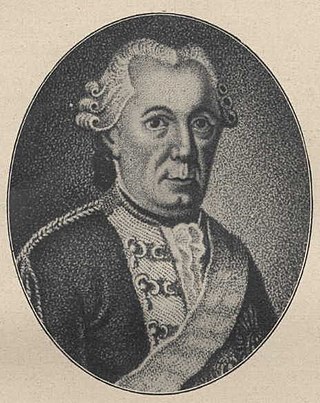
Hans Joachim von Zieten, sometimes spelled Johann Joachim von Ziethen,, also known as Zieten aus dem Busch, was a cavalry general in the Prussian Army. He served in four wars and was instrumental in several victories during the reign of Frederick the Great, most particularly at Hohenfriedberg and Torgau. He is also well known for a raid into the Habsburg territories during the Second Silesian War, known as Zieten's Ride. After engaging in a reputed 74 duels, and fighting in four wars, he died in his bed at the age of 86.

The Order of the Black Eagle was the highest order of chivalry in the Kingdom of Prussia. The order was founded on 17 January 1701 by Elector Friedrich III of Brandenburg. In his Dutch exile after World War I, deposed Emperor Wilhelm II continued to award the order to his family. He made his second wife, Princess Hermine Reuss of Greiz, a Lady in the Order of the Black Eagle.

Hans von Lehwald(t) (24 June 1685 – 16 November 1768), also known as Johann von Lehwald(t), was a Prussian Generalfeldmarschall. He joined the military in 1700 and participated in all Prussian field operations from the War of Spanish Succession through the Seven Years' War. He served with particular distinction in Frederick the Great's war with the Austrians in the Silesia and Seven Years' War.

The ancient German noble family of Pfuel arrived in Brandenburg in the year 926 and later widened their influence to Saxony, Saxony-Anhalt, Mecklenburg, Pomerania, Württemberg, Westphalia, Eastern Europe and Sweden.

General der Artillerie may mean:
Joachim Ludwig Schultheiss von Unfriedt was a German Baroque architect, official, and councillor most active in Königsberg and throughout East Prussia.

The Schlosskirche or Schloßkirche was a Protestant church within Königsberg Castle in Königsberg, Germany.

Hans Lohmeyer was a German jurist, Lord Mayor of Königsberg.
Karl Georg Heinrich Bernhard von Poten, known as Bernhard von Poten, was a royal Prussian colonel best known for his military writing.

Christoph II, Burggraf and Count of Dohna-Schlodien was a Prussian general. He was the son of Christopher I, Burgrave and Count of Dohna-Schlodien (1665–1733). He served in the armies of Frederick William I of Prussia and his son, Frederick II, in the Silesian and Seven Years' wars. He was particularly successful at the Battle of Gross-Jägersdorf, and instrumental in relieving Siege of Kolberg.

Karl Wilhelm von Dieskau was a Prussian lieutenant general and general inspector of the artillery. He participated in twelve campaigns, ten battles, nine sieges. He received the Black Eagle Order, the Order Pour le Mérite, and was included in 1851 on the Equestrian statue of Frederick the Great. He is general credited with creating Frederick the Great's vaunted horse artillery.

Johann Dietrich von Hülsen was a Prussian lieutenant general of the infantry. After a lifelong officer's career in various infantry regiments, he acquired the special respect of Frederick II in the Seven Years' War as general, and was honored by him with the appointment as governor of Berlin. During the war, he became a canon to Minden and was awarded the Black Eagle Order and the Order Pour le Mérite. His name appears on the top tier of the Equestrian statue of Frederick the Great.

Dubislav Friedrich von Platen was a Prussian officer in Frederick the Great's army. A cavalry general, he was also Governor of Königsberg, a Knight of the Order of Saint John, and a recipient of the Order of the Black Eagle. An active cavalry officer in all of the wars fought by Frederick—the War of Austrian Succession, the Second Silesian War, the Seven Years' War and, finally, the War of Bavarian Succession — he was commemorated on Equestrian statue of Frederick the Great in 1851 erected by Frederick's great-great nephew, Frederick William IV.
Hans-Friedrich von Krusemark, sometimes spelled Krusemarck, was a Lieutenant General in the Prussian Army of Frederick the Great.
Ernst Wilhelm von Schlabrendorf was a Prussian state minister for Silesia and president of the Silesian chamber. He was the son of the estate owner Johann Christian von Schlabrendorf, of Gröben, Groß- und Klein-Beuthen and Waßmannsdorf in Teltow, and his wife Anna Augusta Elisabeth von Pfuel. The major general Gustav Albrecht von Schlaberndorf was his brother. On 5 December 1767 Frederick the Great awarded him with the Black Eagle Order. He is included among the relief figures on the Equestrian statue of Frederick the Great, erected in Berlin in 1851.
Johann Karl Friedrich zu Carolath-Beuthen was an independent prince and Prussian general in the service of Frederick the Great.

Kasimir Wedig von Bonin, also called Casimir Wedigo von Bonin, was a Prussian lieutenant general during the reigns of Frederick William I and his son, Frederick the Great.

Anton Friedrich von Krockow (4 January 1714 – 7 September 1778) was a Prussian lieutenant general.
William Dietrich von Wakenitz, also Wackenitz or Wacknitz, 2 August 1728 on the family estate at Neu Boltenhagen–9 January 1805 in Kassel). He served in the Prussian army during the War of Austrian Succession and the Seven Years' War as a cavalry officer; subsequently, he served the Landgraviate of Hesse-Kassel as general and finance minister.

Karl Friedrich von Moller was a Prussian colonel of artillery. His uncanny genius at setting up artillery parks gave Frederick the Great high confidence in the artillery's ability to effect the outcome. During the Seven Years' War, Moller gained great fame specifically for his actions at Lobositz, Rossbach and Zorndorf.















